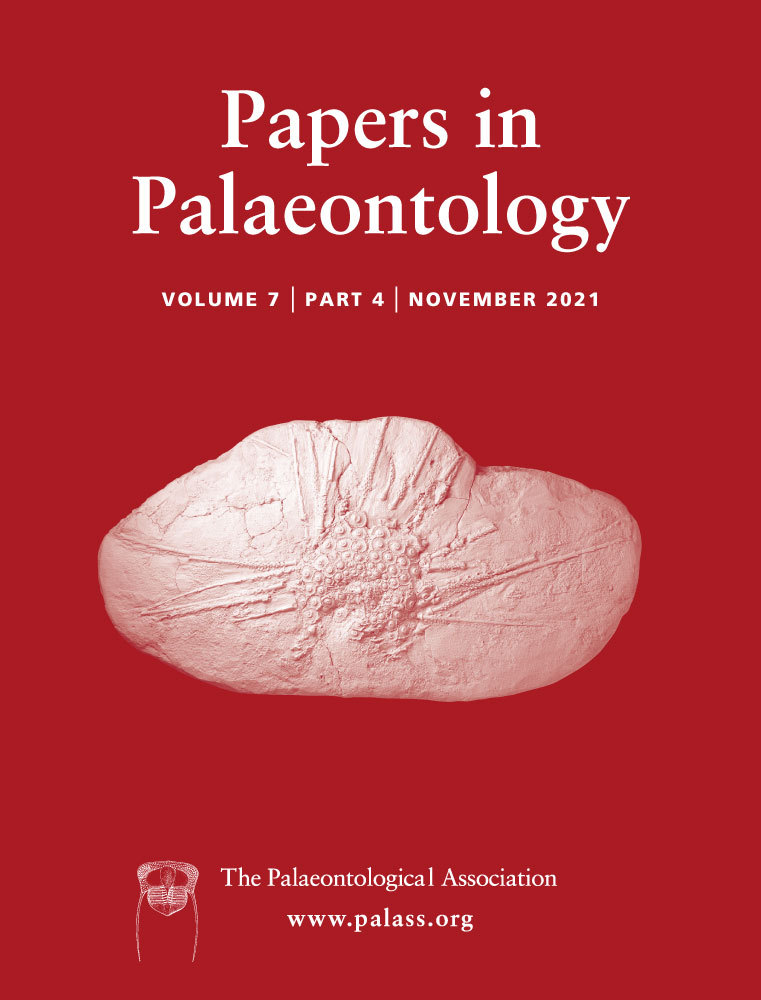Silurian (late Llandovery – Wenlock) conodont fauna and biostratigraphy from the Yanbian area of Sichuan Province, south-west China
Abstract
Late Llandovery and Wenlock conodonts are still inadequately documented in China, with data collected chiefly from the Baizitian section in Yanbian County, Sichuan Province, south-west China. A collection of over 32 000 conodont elements was recovered from 38 samples from the Xiabaizitian and Shangbaizitian formations at this classic locality. The conodont fauna is dominated by cosmopolitan species and can be assigned to 50 species representing 17 genera. Of these, one new species, Apsidognathus yanbianensis sp. nov., is proposed herein. Six conodont zones are recognized in this section, including the Pterospathodus eopennatus Zone, the Pt. amorphognathoides angulatus Taxon-range Zone of the Pt. a. amorphognathoides Superzone, the Kockelella ranuliformis Zone, the Kockelella walliseri Taxon-range Zone, and the Kockelella patula Taxon-range Zone, in ascending order. These zones can be correlated with other conodont zones around the world based on the occurrences of the stratigraphically diagnostic species. Moreover, the stratigraphical ranges of Pterospathodus enable greater understanding of the correlation of the Telychian guide taxa. The conodont biodiversity changes and faunal turnover across the Silurian Ireviken Bioevent are here documented for the first time in the Baizitian section from the South China palaeoplate.
Conodonts are primary index fossils in the Silurian due to their wide distribution and high evolutionary rate. The past six decades have seen massive advances in Silurian conodont taxonomy and biostratigraphy (e.g. Walliser 0107; Aldridge 1; Klapper & Murphy 53; Barrick & Klapper 8; Mabillard & Aldridge 64; Armstrong 6; McCracken 73, b; Simpson & Talent 96; Jeppsson 44; Corradini & Serpagli 25; Zhang & Barnes 124; Männik 66; Wang & Aldridge 112; Cramer et al. 28; Corradini et al. 26; Zhang et al. 125; Barrick & Meyer 9). The Silurian conodont systematics have switched to multielement taxonomy from form taxonomy (Walliser 0107). The highest-resolution conodont zonations were established from the Silurian successions from the Baltic region (Jeppsson 44; Jeppsson et al. 47; Männik 65, 66), and were adopted as a global zonation scheme (Cramer et al. 28). In contrast, early–middle Silurian conodont fauna and zonations are less documented from Laurentia, Siberia, and Gondwana. In order to refine the framework of the global conodont zonations, it is essential to compare the conodont fauna and biostratigraphy from various palaeobasins.
The Ireviken Bioevent (IBE) was a profound biotic turnover event spanning the Llandovery–Wenlock boundary interval (Aldridge et al. 4; Jeppsson 45; Calner 14; Lehnert et al. 56; Molloy & Simpson 79; Spiridonov et al. 97; Zhang et al. 125). About 80% of conodont species disappeared in this event (Jeppsson 45). Up to now, data spanning the IBE in South China have been sparse.
In South China, previous studies focused on early (Llandovery) and late (Ludlow and Pridoli) Silurian conodonts (Zhou et al. 127; Ding & Li 29; An 5; Wang et al. 114; Jin et al. 49, 50; Wang 0109; Wang & Aldridge 112; Yan et al. 121; Chen et al. 18), but rarely investigated Wenlock conodonts due to the rarity of the equivalent strata. So far as is known, the Yanbian region in Panzhihua of Sichuan Province, south-western China, is one of the critical areas to study the late Llandovery – Wenlock conodonts in China (He & Qian 37; Jin et al. 51; Wang et al. 116; Ji et al. 48; Wang et al. 118). The Baizitian section in the Yanbian region is remarkable in recording the late Llandovery and Wenlock conodonts. Previous studies on Llandovery and Wenlock conodonts have documented a few of the zonal taxa (i.e. He & Qian 37; Jin et al. 51; Wang et al. 116). There has been a paucity of conodont specimens, thus hindering the high-resolution correlation of conodont biostratigraphy. For example, previous studies reported the presence of Pterospathodus eopennatus, P. amorphognathoides aff. lennarti, P. a. amorphognathoides and Kockelella patula, but other biostratigraphical guide taxa such as P. a. angulatus, P. a. lithuanicus, K. ranuliformis, Pseudooneotodus bicornis and K. walliseri were not documented. Consequently, re-investigation of the conodonts from the classic Baizitian section using a larger sampling strategy is crucial to clarify the conodont fauna, and the high-resolution framework of conodont biostratigraphy, and faunal dynamics during the late Llandovery – Wenlock interval in the South China palaeoplate.
Based on the conodonts from the Xiabaizitian and Shangbaizitian formations, this study aims to systematically document the diverse conodont fauna and to update the high-resolution conodont zonation during the interval from the upper Llandovery to the Wenlock of the Baizitian section, Sichuan Province of south-western China. Furthermore, based on the present conodont data, the conodont biodiversity and faunal turnover across the IBE have been analysed in detail for the first time in China.
Geological setting and stratigraphy
During the early Silurian Period, the South China palaeoplate consisted of the Yangtze and Cathaysia blocks (Rong et al. 91). The Silurian successions of two blocks are incomplete and discontinuous due to tectonic movements (e.g. Kwangsian Orogeny; Chen et al. 17). From the Late Ordovician to early Silurian, the Cathaysia Block propagated northwestward and collided with the Yangtze Block (Li et al. 59). During the early Silurian, the Yangtze Block was broadly covered by an epeiric sea and experienced several perpendicular movements (Rong et al. 91).
The Yanbian region is one of the classic areas for Silurian studies of the South China palaeoplate. It is located on the margin of the Yangtze Block and was deposited either in relatively shallow or deep water environments (He & Qian 37; Li & Qian 58; Ji et al. 48). Sediments of early–late Silurian are exposed in this region. The basal part of the succession consists of dark grey to black shales (Lungmachi Formation) of Rhuddanian–Telychian age. The middle part of the succession consists of the Xiabaizitian and Shangbaizitian formations, which are represented by black to light grey limestones and siltstones (Telychian–Homerian). The succession continues with dark grey to light grey limestones (Goukou Formation) of Homerian–Ludfordian age in the south-west part of this region. In the shallower areas, the Homerian–Ludfordian limestones are represented by the Zhongcao Formation (Wang et al. 118).
The Baizitian section was measured and sampled for conodonts (Yan & Wu 120). The section is situated in Yanbian County, Sichuan Province, south-western China (GPS: N 27°04′20″, E 101°20′28″, Fig. 1). It is well-exposed and is located along the road connecting Qinghe and Yankou. The section consists of the Lungmachi, Xiabaizitian, Shangbaizitian, and Goukou formations, in ascending order. The Lungmachi Formation contains two members with a thickness of 92 m (Lei et al. 57). The Lower Member consists of chert and limestone lenses, and the Upper Member consists of silty mudstone and clayey siltstones (Lei et al. 57). The graptolites of the Lungmachi Formation are suggestive of a Rhuddanian–Aeronian age (He & Qian 37). The last three units are dominated by carbonates and yield conodonts suggestive of a late Llandovery – Ludlow age (He & Qian 37; Wang et al. 116; Wang et al. 118). The Xiabaizitian Formation is c. 26 m thick. It consists of medium to thick-bedded, light grey limestone with occasional small nodules (Fig. 2). The overlying Shangbaizitian Formation has a thickness of 39 m. It is typified by a lithology of wackstone, with black mudstone intercalations in its lower portion (c. 12 m) and dark grey wackstone interbeds in the middle and upper parts (c. 27 m). The Goukou Formation is characterized by argillaceous limestone and has a total thickness of c. 68 m (Wang et al. 118).
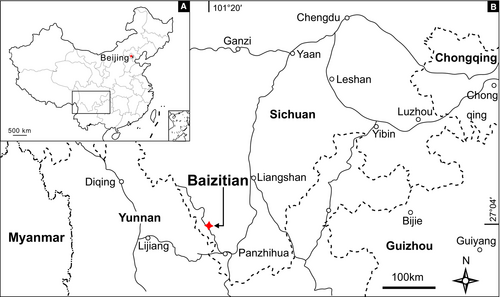
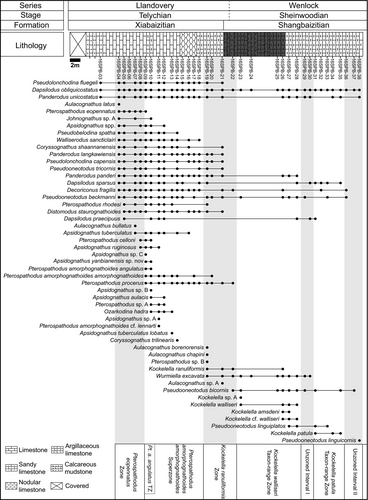
Previous studies in the Baizitian section
The Baizitian section is of great importance for the late Llandovery and Wenlock conodont faunas in south-west China. Several authors have conducted studies on Silurian conodonts in this section, mainly focused on the Silurian–Devonian boundary (He & Qian 37; Jin et al. 51; Wang et al. 116). Of the Llandovery and Wenlock strata, He & Qian (37) have proposed a preliminary conodont zonation without illustrations of any conodont taxa. Subsequently, Jin et al. (51) illustrated several biostratigraphically useful conodont taxa recovered from the Baizitian section, and Wang et al. (116) updated the conodont zonation scheme. None of the previous reports has documented the stratigraphic ranges of conodonts of this section.
He & Qian (37) documented the Pterospathodus celloni–Hadrognathus staurognathoides Assemblage Zone, the Pterospathodus amorphognathoides Zone and the Neoprioniodus latidentatus Zone from the Xiabaizitian Formation, in ascending order. Later, Jin et al. (51) reported a conodont zonation from the Baizitian section, including the Pterospathodus celloni and P. amorphognathoides zones in the Xiabaizitian Formation, and the Ozarkodina sagitta rhenana and O. bohemicus zones in the Shangbaizitian Formation. The following study by Wang et al. (116) documented the Pterospathodus eopennatus, P. celloni, P. amorphognathoides amorphognathoides and P. pennatus procerus zones in the Xiabaizitian Formation, and the Ozarkodina sagitta rhenana and Kockelella patula zones in the Shangbaizitian Formation.
In addition to conodonts, He & Qian (37) discovered graptolites in the Lungmachi and Shangbaizitian formations. Carbonate carbon isotopes were analysed from the Silurian strata of the Baizitian section by Wang et al. (118), who identified a Telychian and a Homerian carbon isotope excursion.
Material and method
For this study, 38 conodont samples were collected from the Baizitian section: 21 from the Xiabaizitian Formation and 17 from the Shangbaizitian Formation. Each sample weight of c. 8 kg was processed using the diluted buffered acetic acid technique proposed by Jeppsson et al. (46). Heavy liquid (sodium polytungstate with a density of c. 2.80 g/cm3) was used to separate insoluble residues. The specimens were finally picked from the heavy fraction under a binocular microscope (Olympus, SZX-7). The conodont extraction was carried out at the Nanjing Institute of Geology and Palaeontology, Chinese Academy of Sciences (NIGPAS). In total, 32 025 identifiable conodont elements were recovered. Most conodont images were taken with a scanning electron microscope. Images of Walliserodus and two specimens of Dapsilodus were taken using a Zeiss Axio Zoom V16 microscope and Zeiss ZEN software to show the colour and outline of the specimens. All specimens are deposited in the NIGPAS (repository numbers: NIGP).
Conodont fauna from the Baizitian section
Late Llandovery and Wenlock conodont faunas are primarily characterized by cosmopolitan taxa (Bergström 10). In general, conodonts of Baizitian collections show a dominance of coniform taxa. Ramiform and platform-equipped elements are diverse but have a relatively low abundance.
In regards to Telychian conodonts, 26 205 specimens have been recovered from the Xiabaizitian Formation. The most abundant genus is the coniform Panderodus, which comprises 43% of the sample; Pseudolonchodina, Dapsilodus and Decoriconus are moderate in abundance, at 14%, 14%, and 10%, respectively (Fig. 3). The biostratigraphically significant genus Pterospathodus comprises 10% of the Telychian conodonts. In this Telychian fauna, the coniform Walliserodus and Pseudooneotodus are common. Some genera, including Aulacognathus, Johnognathus, Kockelella, Pseudobelodella and Wurmiella, are recovered from the Xiabaizitian Formation for the first time.
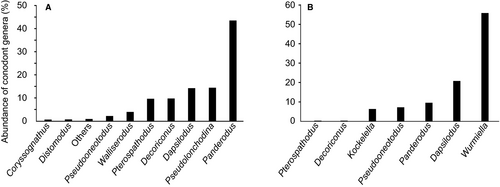
The Sheinwoodian conodonts are mainly collected from the Shangbaizitian Formation. Apart from sample 16SPB-26, which includes more than 2800 Wurmiella excavata elements, most samples have a low abundance of Sheinwoodian conodont fauna. The coniforms Dapsilodus, Panderodus and Decoriconus are representative of the common genera. Kockelella contributes 6% to the Sheinwoodian conodont fauna.
Conodont biostratigraphy and correlation
According to the stratigraphic ranges of conodont species, six conodont zones, and two unzoned intervals, are recognized and are described here in ascending order. The correlation of the six conodont zones in this study to the Baltic, North American, and Australian zonations is presented in Figure 4.
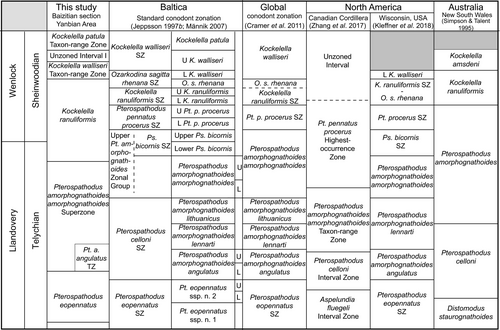
Pterospathodus eopennatus Zone
The base of the P. eopennatus Zone is defined by the first occurrence of P. eopennatus Männik (Männik 65). In the Baizitian section, the P. eopennatus Zone corresponds to the lower part of the Xiabaizitian Formation, from sample 16SPB-04 to 16SPB-08, with a thickness of c. 4 m (Fig. 2). The dominant elements are species of Panderodus and Dapsilodus. Associated conodont fauna include Aulacognathus bullatus (Nicoll & Rexroad), Aulacognathus latus (Nicoll & Rexroad), Apsidognathus tuberculatus Walliser, Distomodus staurognathoides (Walliser), Pseudooneotodus tricornis Drygant, and Johnognathus sp. A. Most of the species in this zone extend into the lower part of the Pterospathodus amorphognathoides amorphognathoides Superzone (Fig. 2).
Pterospathodus eopennatus is a characteristic zonal species. Based on the stratigraphic ranges of P. eopennatus and P. amorphognathoides angulatus (Walliser), the top of the present P. eopennatus Zone can be roughly correlated to the upper part of the P. eopennatus Superzone in Baltica (Männik 66). According to the overlapping range of P. eopennatus and P. celloni, the top of the present P. eopennatus Zone can be roughly correlated to the lower parts of the P. celloni zones for the Canadian Arctic and Canadian Cordillera (McCracken 74; Zhang et al. 125). Pterospathodus eopennatus has also been documented in the lower part of the P. celloni Zone from New South Wales, Australia (Bischoff 11; Simpson & Talent 96; Männik 65). The presence of P. eopennatus and P. celloni in New South Wales suggests that the upper part of the present P. eopennatus Zone is correlated with the lower part of the P. celloni Zone for New South Wales.
Pterospathodus amorphognathoides amorphognathoides Superzone
The base of this superzone is marked by the first occurrence of Pterospathodus amorphognathoides amorphognathoides, and the top is marked by the first occurrence of Kockelella ranuliformis (Walliser). It extends from sample 16SPB-09 (at 11.6 m) to sample 16SPB-18 (at 21.8 m). Other representative species of this superzone are P. a. angulatus, P. a. cf. lennarti Männik, Apsidognathus lobatus Bischoff, A. aulacis Zhou, Zhai & Xian, and A. yanbianensis sp. nov.
The base of this zone, which evidences the appearance of P. a. angulatus, can be correlated to the strata represented by the P. a. angulatus Zone elsewhere (e.g. Männik 66; Waid & Cramer 0105). Further, the presence of P. a. cf. lennarti in the middle Xiabaizitian Formation is a significant tie for potential correlation with the P. a. lennarti Zone in Baltica (Männik 66).
In our collections, P. a. amorphognathoides co-occurred with P. a. angulatus and P. procerus. The range of P. a. angulatus is normally diachronous, showing that its first appearance datum (FAD) in shelf to slope environments may be earlier than in platform settings. Männik (65) reviewed the previous publications and concluded that P. a. amorphognathoides shows a basinward replacement by P. pennatus procerus, whereas the material from Latvia and the Canadian Artic Islands show co-occurrences of the two taxa (Loydell et al. 62; Zhang et al. 125).
Pterospathodus amorphognathoides angulatus Taxon-range Zone
This zone is part of the P. a. amorphognathoides Superzone. The lower and upper boundaries are defined by the first and last occurrences of P. a. angulatus. In this zone, samples 16SPB-09 and 16SPB-10 were collected from the middle part of the Xiabaizitian Formation. As noted above, the base of this zone is equivalent to the lower boundary of the P. a. amorphognathoides Superzone. The appearance of P. a. angulatus indicates that this zone is potentially correlated to the P. a. angulatus Zone elsewhere.
Kockelella ranuliformis Zone
This zone spans the boundary of the Xiabaizitian and the Shangbaizitian formations. The base is marked by the first occurrence of Kockelella ranuliformis, and the top is limited by the first occurrence of Kockelella walliseri (Helfrich). In the Baizitian section, this zone includes four samples (16SPB-19, 16SPB-20, 16SPB-21, 16SPB-22), with a thickness of c. 6.4 m. Associated taxa include Pterospathodus procerus, Pseudooneotodus tricornis Drygant, Ps. bicornis Drygant, Pseudolonchodina fluegeli, Ps. capensis (Savage), Aulacognathus chapini (Savage), Aulacognathus borenorensis Bischoff, and Wurmiella excavata (Branson & Mehl).
Kockelella ranuliformis has been widely reported from the upper Telychian (e.g. Aldridge 1; Männik 67). The base of this zone is correlated with the upper part of the Pterospathodus amorphognathoides amorphognathoides Zone in Baltica (Männik 66). Pseudooneotodus bicornis is a pandemic species during the latest Llandovery and Wenlock and has been considered as a useful marker for the base of the Wenlock (Jeppsson 44; Corradini 23). In the Baizitian section, P. bicornis occurs above the stratigraphic range of P. tricornis. The first occurrence of P. bicornis in sample 16SPB-22 and the last occurrence of P. tricornis in sample 16SPB-21 indicate that the upper part of the Kockelella ranuliformis Zone can be correlated with the Pseudooneotodus bicornis Superzone in Baltica (Männik 66), although the lower boundary of the Ps. bicornis Superzone was defined by the extinction of Nudibelodina sensitiva Jeppsson (Jeppsson 44).
Kockelella walliseri Taxon-range Zone
The K. walliseri Taxon-range Zone corresponds to the total range of the eponymous species. Eight samples were collected from the lower part of the Shangbaizitian Formation, of which five samples yielded abundant conodonts. This zone corresponds to sample 16SPB-23–16SPB-28, with a thickness of c. 10.7 m. The associated conodont fauna includes K. amsdeni Barrick & Klapper, Dapsilodus obliquicostatus, Wurmiella excavata, Panderodus unicostatus (Branson & Mehl) and Decoriconus fragilis (Branson & Mehl).
Kockelella walliseri is an index fossil for the lower Wenlock strata, which occurs in a shallow water environment (Jeppsson 41, 44). Cramer et al. (27) noted that Kockelella walliseri first appears lower in Laurentia than in Baltica, probably caused by palaeobiogeographical variability. In the Baizitian section, this species co-occurs with K. ranuliformis in the Shangbaizitian Formation. Hence, the base of the Kockelella walliseri Taxon-range Zone corresponds to the lower Wenlock. But it should be noted that a depositional gap is probably present at the lowermost part of the Shangbaizitian Formation.
The upper part of this zone is referred to as the lower part of the Kockelella amsdeni Zone of Oklahoma, USA of Barrick & Klapper (8) based on the co-occurrence of K. amsdeni and K. walliseri. Accordingly, the upper part of this zone can be correlated with the Lower K. walliseri Zone and Middle K. walliseri Zone of Jeppsson (44).
Unzoned interval I
This interval contains samples 16SPB-29 and 16SPB-30, with a thickness of c. 2 m. Only long-ranging taxa occur in this interval.
Kockelella patula Taxon-range Zone
This zone is marked by the lower and upper occurrence limits of Kockelella patula Walliser. It extends from sample 16SPB-31 (43.9 m) to sample 16SPB-36 (48.7 m). Associated taxa include Dapsilodus obliquicostatus, Dapsilodus sparsus Barrick, Pseudooneotodus bicornis and Pseudooneotodus linguiplatos Wang.
The K. patula Zone was described by Walliser (0107) in the Cellon section, Austria. Jeppsson (44) defined the K. patula Zone above the Middle K. walliseri Zone, and below the uppermost of the K. walliseri range. The K. patula Zone redefined by Jeppsson (44) is equivalent to the middle and upper part of the K. walliseri Zone in Cramer et al. (28). However, the co-occurrence of K. patula and K. walliseri is rarely reported. As noted by Corradini et al. (26), K. walliseri has not been recorded from the Cellon section, where the K. patula specimens were frequently recovered. In the Baizitian section, K. patula was above the range of K. walliseri. Therefore, the K. patula Taxon-range Zone is roughly equivalent to the upper part of the K. walliseri Superzone of Jeppsson (44) and Melchin et al. (76). In the Canadian Arctic, Zhang et al. (125) recognized an unzoned interval with the conodonts Wurmiella excavata and K. patula recorded. The Unzoned Interval of Zhang et al. (125) is higher than the last occurrence of K. ranuliformis. Therefore, the Kockelella patula Taxon-range Zone is probably coeval with the middle part of the Unzoned Interval of Zhang et al. (125).
Unzoned interval II
This interval was recorded in the upper part of the Shangbaizitian Formation. It should be noted that Pseudooneotodus linguicornis Jeppsson first appears in this interval. Pseudooneotodus beckmanni Bischoff & Sannemann, Ps. bicornis and Dapsilodus obliquicostatus are also recorded in this interval.
Pseudooneotodus linguicornis was documented from the Ozarkodina sagitta sagitta Zone and Subzone 0 of the Ozarkodina bohemica longa Zone in Baltica (Männik & Małkowski 69; Calner & Jeppsson 15; Corradini 23; Loydell et al. 62; Corradini et al. 26; Schönlaub et al. 2017). Hence, the occurrence of Pseudooneotodus linguicornis indicates that the sample 16SPB-38 corresponds to late Sheinwoodian or early Homerian in age.
Conodont biodiversity changes across the IBE
It is widely recognized that the Silurian was characterized by dramatic environmental and climate changes (Jeppsson 43, 45; Lehnert et al. 56; Trotter et al. 0103; Rong et al. 91). The IBE, spanning the Llandovery–Wenlock boundary, is a profound biotic and environmental turnover event in the Silurian (Jeppsson 45; Munnecke et al. 81; Molloy & Simpson 79; Zhang et al. 125).
The conodont faunal turnover occurs at the base of the Shangbaizitian Formation at Baizitian according to the first occurrence of Pseudooneotodus bicornis. In 16SPB-22, only one Pa element of Pterospathodus procerus has been obtained, indicating that 16SPB-22 is situated under the ending bed of the IBE. The common Telychian taxa of Aulacognathus, Apsidognathus, Distomodus, Pterospathodus and Pseudolonchodina have not been observed in sample 16SPB-22. The first occurrence of Kockelella walliseri in sample 16SPB-23 indicates that conodont fauna was in the recovery phase after the IBE.
As shown in Figure 5, conodont biodiversity curves can be divided into three sections: pre-IBE, IBE and post-IBE. In the Xiabaizitian Formation, the richness of conodont species and genera are relatively high. The taxonomic richness peaks in the middle Xiabaizitian Formation (Pterospathodus amorphognathoides amorphognathoides Superzone). It corresponds to the lower part of the Pterospathodus amorphognathoides angulatus Taxon-range Zone of the Pterospathodus amorphognathoides amorphognathoides Superzone. A sharp decline in conodont diversity can be observed at the base of the Shangbaizitian Formation, representing the IBE in the Baizitian section. Only several species have been collected from the Shangbaizitian Formation.
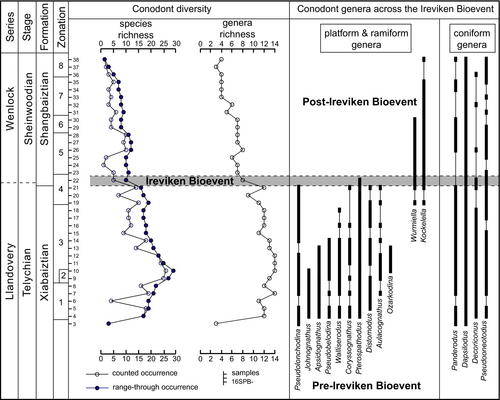
Most Telychian platform-equipped conodonts disappeared above the Llandovery–Wenlock boundary, as well as some coniform species (Jeppsson 42). In the Baizitian section, several species survive the IBE. They are Dapsilodus obliquicostatus, D. sparsus, D. praecipuus, Pseudooneotodus beckmanni, Kockelella ranuliformis, Wurmiella excavata, Decoriconus fragilis, Panderodus unicostatus and P. panderi. However, Panderodus species is not present from 16SPB-22 to 16SPB-25 of the lower Shangbaizitian Formation. After the IBE, the conodont fauna is dominated by species of Dapsilodus, Decoriconus, Kockelella, Panderodus and Wurmiella in the K. walliseri Taxon-range Zone. In this study, none of the datum points within the IBE can be recognized. Possibly the IBE is not fully documented in the lower Shangbaizitian Formation at Baizitian.
Remarks on the lineage of Pterospathodus
Due to its wide distribution and rapid morphologic evolution, Pterospathodus is an excellent index fossil in conodont zonal schemes (e.g. Walliser 0107; Jeppsson 44; Männik 65; Cramer et al. 28; Corradini et al. 26; Schönlaub et al. 2017). Therefore, the evolutionary lineage and stratigraphic sequences of the genus Pterospathodus have attracted much attention during the past few decades (e.g. Bischoff 11; Männik & Aldridge 68; Männik 65; Dzik 34). Several evolutionary lineages of Pterospathodus have been proposed by Männik (65) based on the Estonian and Swedish material and applied to the Baltic conodont zonation (Männik 66). However, recent investigations documented Pterospathodus from shelf to slope settings, implying that the Pterospathodus successions are not consistent with those previously recognized from the Estonian successions (Fig. 6; Männik 65; Pyle & Barnes 86; Zhang et al. 125). Hence, the Telychian and lower Sheinwoodian conodont biostratigraphic correlation based on Pterospathodus might be limited in different palaeobasins.
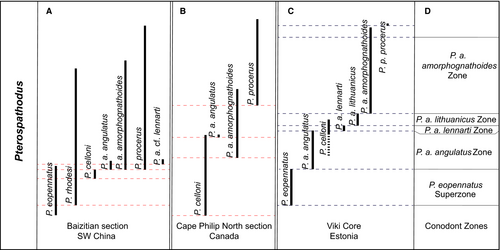
Comparison of the sequences of Pterospathodus
Figure 6 shows the stratigraphic sequences of the species of Pterospathodus from the selected sections or core in South China, Canada, and Estonia (Männik 66; Zhang et al. 125; this study). As can be seen, P. eopennatus appeared earlier than other species in the Viki core (Männik 66) and the Baizitian section. P. procerus is stratigraphically higher in the Baizitian section, the Cape Philip North section, and the Viki core. The main difference is the apparent discrepancy of first appearances of the subspecies of P. amorphognathoides. In Estonia, the subspecies are recorded from older to younger strata without overlapping (Fig. 6C, Männik 66). In the Viki Core, P. a. angulatus is found in older strata than the ranges of other subspecies. Stratigraphically, the youngest subspecies P. a. amorphognathoides are recorded higher than any other subspecies (Männik 66). In contrast, P. a. amorphognathoides, P. a. angulatus, and P. a. cf. lennarti co-occurred in the middle Xiabaizitian Formation in the Baizitian section. Similarly, P. a. angulatus and P. a. amorphognathoides co-occurred in the Cape Philip North section in Canada (Zhang et al. 125). No specimens of P. a. lennarti or P. a. lithuanicus are recorded from the Baizitian section or the Cape Philip North section. The first appearance of P. celloni is lower than P. a. angulatus in the Baizitian section and in the Cape Philip North section, while P. a. angulatus is stratigraphically lower than P. celloni in the Viki Core.
Lineage of Pterospathodus
The stratigraphically oldest species currently recognized in the Pterospathodus lineages is P. eopennatus, the index of the P. eopennatus Zone (or Superzone of Männik 66). The stratigraphically youngest species is P. procerus. Of similar stratigraphic ranges are the species P. celloni, P. rhodesi and subspecies of P. amorphognathoides. Bischoff (11) and Männik & Aldridge (68) have described the evolutionary changes of the Pterospathodus populations. Later, Männik (65) studied the taxonomy and evolution of Pterospathodus in detail based on the Estonian and Swedish material. Männik (65) proposed three evolutionary lineages of the genus Pterospathodus: the P. eopennatus lineage, the P. amorphognathoides lineage and the P. pennatus lineage. Within the P. eopennatus lineage, P. eopennatus ssp. n. 1 was replaced by P. eopennatus ssp. n. 2. The P. amorphognathoides lineage contains a P. a. angulatus–P. a. lennarti–P. a. lithuanicus–P. a. amorphognathoides sequence. The P. pennatus lineage was assumed as P. p. pennatus–P. p. procerus (Männik 65).
Observations based on the material of South China and Canada indicate that the phylogenetic pattern of Pterospathodus may need to be reconsidered (Fig. 6). As described by Männik (65), P. a. angulatus probably represents a direct descendant of P. eopennatus. The Pa element of P. a. angulatus shows denticulation derived from that of P. eopennatus. According to the new comparison, P. a. amorphognathoides might be derived from P. eopennatus directly, rather than from P. a. lithuanicus as shown by the Estonian material. The Pa elements of P. a. amorphognathoides are characterized by platform ledges that are different from those of P. eopennatus. Although the subspecies P. a. lennarti and P. a. lithuanicus are rarely seen outside Baltica (Männik 66), their Pa elements are different from those of P. a. angulatus in the presence of bifurcated lateral processes, and from those of P. a. amorphognathoides in the lack of platform ledges (Männik 65). Hence, they could not represent the intermediate forms between P. a. angulatus and P. a. amorphognathoides. Both P. a. angulatus and P. a. amorphognathoides might have deviated from P. eopennatus. Potentially the denticulation and platform configuration evolution could have occurred simultaneously.
In the Baizitian collections, P. procerus are commonly found in the strata. Among Pa elements of P. procerus, the younger forms have a strong platform ledge and the older forms have weak ones. The intermediate forms in the Baizitian section are normally characterized by intermediate-strength platform ledges. As such, P. procerus is described as a descendant of P. eopennatus in this paper.
Biostratigraphic implications
The Pterospathodus successions have been used to establish the Telychian conodont zonations (Walliser 0107; Bischoff 11; Jeppsson 44). On the basis of the evolution of Pterospathodus, Männik (66) updated the Baltic Telychian conodont zonation, including the P. eopennatus Superzone, P. a. angulatus Zone, and P. a. amorphognathoides Zone, which can be correlated with other regions readily (e.g. Waid & Cramer 0105; Zhang et al. 125) and it has been adopted as a global zonal scheme by Cramer et al. (28).
As shown in Figure 6, the global Telychian zonations are directly correlated with the Pterospathodus records in the Estonian strata of Männik (66). It should be pointed out that all Baltic Telychian zones correspond to the total ranges of the nominal taxa, according to the way each zone or superzone was defined (Männik 66). For instance, the total range of P. a. angulatus has been defined as the P. a. angulatus Zone in Estonia (Männik 66). Also, the taxa were documented from older to younger strata, with overlapping being rare in Estonia (Männik 66). As such, the zones are well-defined in Estonia. However, it is difficult to apply the Baltic zonation to other regions. Due to a lack of index fossils, the P. a. lennarti and P. a. lithuanicus zones currently cannot be used in South China and Canada (Wang & Aldridge 112; Zhang et al. 125; this study). The difficulties come from the apparent discrepancy in the occurrences of the index taxa (e.g. in Fig. 6). Both the P. a. angulatus Zone and P. a. amorphognathoides Zone were defined as the total ranges of the nominal taxa (Männik 66), however, the material from South China and Canada indicate that P. a. amorphognathoides may not be younger than P. a. angulatus, nor is it younger than P. a. angulatus in the Estonian material. The range of P. a. angulatus is totally recorded within the P. a. amorphognathoides Taxon-range Zone of Zhang et al. (125), or the P. a. amorphognathoides Superzone of this study. Therefore, it is difficult to separate the P. a. angulatus and P. a. amorphognathoides zones in South China by the total ranges or the FAD of the nominal taxa.
The occurrences of P. celloni also hampered the zonal correlations between the Baizitian section and the Viki core. Männik (66) established the P. celloni Superzone, which corresponds to the interval between the FADs of P. a. angulatus and P. a. amorphognathoides. In the Baizitian section, the P. celloni Superzone cannot be recognized. Similarly, Zhang et al. (125) reported a P. celloni Interval Zone below the P. a. amorphognathoides Taxon-range Zone in Canada.
Possible causes of apparent discrepancies in Pterospathodus
The apparent discrepancies in the occurrence of species or subspecies of Pterospathodus in the different areas might be attributed to the conodont palaeoecology. Männik (65) noted that P. a. angulatus, P. a. lennarti, and P. a. lithuanicus were normally abundant in shallower water, and that P. a. amorphognathoides shows a basinward rarity. Further, P. celloni prefers a proximal carbonated terrigeneous facies (Männik 65).
The Baizitian section and the Cape Philip North section (Zhang et al. 125) are representative of shelf to slope environments. Therefore, Figure 6 indicates that P. a. amorphognathoides might appear earlier in a relatively deeper-water setting. In this study, P. a. cf. lennarti differs slightly from P. a. lennarti in Baltica (Männik 65) by the lateral process, which probably represents a morphologic variation of P. a. lennarti in the deeper-water environment. P. a. angulatus and P. a. amorphognathoides can be found in various depositional settings (e.g. Männik 65; Corradini et al. 26; Zhang et al. 125).
The Telychian and Sheinwoodian deeper-water conodont faunas have been rarely investigated so far. Thus, further studies on the evolutionary lineages of Pterospathodus from the deeper-water setting would be helpful to improve the globally precise correlation of conodont zonation.
Conclusions
The main results on upper Llandovery and Wenlock conodonts from the Baizitian section can be summarized as follows.
- The Telychian and Sheinwoodian conodont fauna of the Baizitian collections are documented and illustrated. The fauna can be assigned to 50 species representing 17 genera.
- A new conodont species, Apsidognathus yanbianensis sp. nov., was erected based on the Baizitian conodonts.
- The conodont association allows the discrimination of six late Llandovery – Wenlock conodont zones: the Pterospathodus eopennatus Zone, the Pt. amorphognathoides angulatus Taxon-range Zone of the Pt. a. amorphognathoides Superzone, the Kockelella ranuliformis Zone, the Kockelella walliseri Taxon-range Zone and the Kockelella patula Taxon-range Zone.
- In the Baizitian section, conodont biodiversity peaks in the lower Pterospathodus amorphognathoides amorphognathoides Superzone (middle Xiabaizitian Formation). The IBE can be recognized at the base of the Shangbaizitian Formation, based on the conodont biodiversity changes and faunal turnover.
Institutional abbreviation
NIGP, Nanjing Institute of Geology and Palaeontology, Chinese Academy of Sciences, Nanjing, China.
Systematic palaeontology
Most of the Baizitian species documented in the table are well-known taxa that have been previously described in the literature and are therefore only illustrated without re-description. All taxa in Baizitian collections are illustrated. Note that in the synonymy, only critical synonyms are listed here.
The element notation (Pa, Pb, Pc, M, Sa–Sd) of Sweet (0101) is mainly used in this study for apparatuses of ramiform or pectiniform–ramiform elements that have not been identified from natural assemblages or that lack comparison with natural assemblages. The apparatus notation (P1–2, M, S0–4) of Purnell et al. (85) is applied to elements of the families Kockelellidae and Spathognathodontidae. For genus Panderodus, the element notation of Sansom et al. (92) is used herein. With regard to the genera Dapsilodus, Decoriconus and Walliserodus, the apparatus composition is still controversial. Terminology derived from genus names is used for these conical elements (e.g. drepanodontiform element of Decoriconus).
Order BELODELLIDA Sweet, 0101Family DAPSILODONTIDAE Sweet, 0101Genus DAPSILODUS Cooper, 21
Type species
Distacodus obliquicostatus Branson & Mehl, 13.
Dapsilodus obliquicostatus (Branson & Mehl, 13)Figure 7K–O
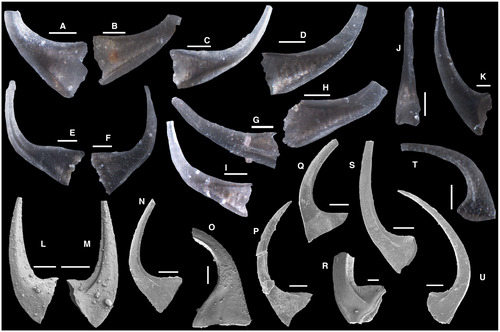
-
- 13
-
- Distacodus obliquicostatus Branson & Mehl, p. 41, pl. 3, fig. 2.
-
- 21
-
- Dapsilodus obliquicostatus (Branson & Mehl); Cooper, p. 212, pl. 2, figs 6, 10–13, 18–20.
-
- 7
-
- Dapsilodus obliquicostatus (Branson & Mehl); Barrick, p. 50–52, pl. 2, figs 6, 10, 13.
-
- 87
-
- Dapsilodus obliquicostatus (Branson & Mehl); Qiu, pp. 27–28, pl. 2, figs 23–25.
-
- 6
-
- Dapsilodus obliquicostatus (Branson & Mehl); Armstrong, pp. 70–71, pl. 7, figs 7–12.
-
- 73
-
- Dapsilodus obliquicostatus (Branson & Mehl); McCracken, pp. 78–79, pl. 4, figs 11, 13–14, 16–28, 30–32, 35, 40.
Material
4368 elements.
Remarks
This species is a long-ranging taxon that inhabited mainly the outer shelf environment (Cooper 21; Armstrong 6; Corradini & Corriga 24). A large number of D. obliquicostatus elements have been recovered in the present study, showing the typical oblique striations in the anterior basal margin except the acodontiform element. Notably, some elements lacking the oblique striations are similar to the material of Barrick (7).
Stratigraphic range
This species is known from the Upper Ordovician (Pygodus serinus Zone, Pyle & Barnes 86) to the Pridoli (Upper Oulodus elegans detortus Zone, Corradini & Corriga 24).
Dapsilodus praecipuus Barrick, 7Figure 7P–R
Material
93 elements.
Remarks
Barrick (7) established this species based on specimens from the lower Silurian of Oklahoma, USA. The terminology M, Sa, Sb, and Sc applied by Barrick (7) is equivalent to describing acodontiform, symmetrical distacodontiform, and asymmetrical distacodontiform (Barrick's Sb and Sc) elements.
The fine striations along the antero-lower margin of the symmetrical distacodontiform element and asymmetrical disacodontiform element resemble the features observed in D. obliquicostatus. All elements of this species have a low base. The costae of symmetrical disacodontiform and asymmetrical disacodontiform elements are placed more posteriorly.
This species has been recovered from a deeper shelf environment, with a stratigraphic range from Telychian to Homerian (Loydell et al. 62; Männik et al. 70).
Stratigraphic range
This species is known from the lower Telychian (Distomodus staurognathoides Zone, Loydell et al. 62) to the Homerian (Ozarkodina sagitta sagitta Zone; USA, Barrick et al. 2009; Latvia, Loydell et al. 62).
Order OZARKODINIDA Dzik, 33Family KOCKELELLIDAE Klapper, 52Genus KOCKELELLA Walliser, 0106
Type species
Kockelella variabilis Walliser, 0106.
Kockelella amsdeni Barrick & Klapper, 8Figures 8R–X; 9A–C
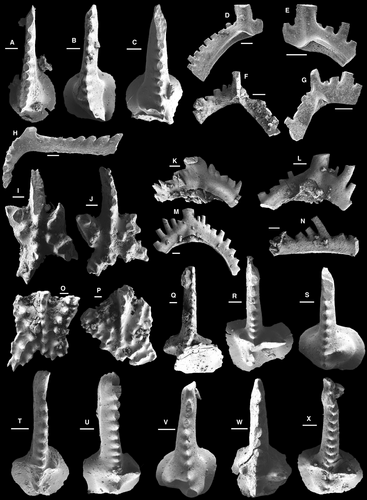
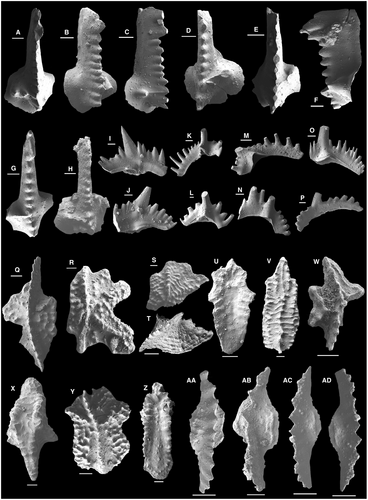
-
- 8
-
- Kockelella amsdeni Barrick & Klapper, p. 74, pl. 2, figs 14, 17–23, 26–30.
-
- 11
-
- Kockelella amsdeni Barrick & Klapper; Bischoff, p. 215, pl. 13, figs 8–26.
-
- 54
-
- Kockelella amsdeni Barrick & Klapper; Kleffner, figs 10.18–10.19.
-
- ? 19
-
- Kockelella amsdeni Barrick & Klapper; Cockle, p. 121, pl. 2, fig. 10.
-
- 30
-
- Kockelella stauros Barrick & Klapper; Dong & Wang, p. 151, pl. 8, fig. 8.
-
- 62
-
- Kockelella amsdeni Barrick & Klapper; Loydell et al., fig. 9cc.
-
- 93
-
- Kockelella ranuliformis (Walliser); Sanz-López et al., fig. 4 g.
Material
21 P1 elements.
Amended diagnosis
P1 element is carminiscaphate, with an elliptic, or round, asymmetrical, expanded basal cavity. The unbranched denticulate process, or nodes, are developed on either side of the main blade. The posterior part of the blade does not reach the posterior margin of the basal cavity. Basal cavity length is slightly shorter than that of the anterior part of the blade. The main blade may be slightly deflected in oral view (amended after Barrick & Klapper 8, p. 74).
Remarks
According to the previous descriptions of Kockelella amsdeni, the P1 element is characterized by having one or two denticulate lateral processes (Barrick & Klapper 8; Bischoff 11). As discussed by Barrick & Klapper (8), K. amsdeni is a descendant of K. ranuliformis. Kockelella amsdeni can be distinguished from K. ranuliformis by a P1 element with lateral processes. The P1 element of K. amsdeni differs from that of K. walliseri by its relatively straight, short posterior process, and the presence of two lateral processes. Compared with K. amsdeni, the P1 element of K. walliseri has a relatively long and strongly incurved posterior blade.
The P2 elements of K. amsdeni and K. walliseri are indistinguishable in Baizitian collections. Two morphological types of the P2 element have been observed, one in which the P2 element bears a broader basal cavity and partially fused denticles, and the other in which a suite of P2 elements have a narrow basal cavity beneath the cusp and relatively discrete denticles on the lateral processes. The M, S0, S1–2 and S3–4 elements of K. amsdeni cannot be distinguished from K. walliseri (Barrick & Klapper 8). The M and S elements in this study show more confluent denticles on the processes than those illustrated by Barrick & Klapper (8) and Bischoff (11).
Stratigraphic range
This species is known in the lower Sheinwoodian Stage, Kockelella walliseri Taxon-range Zone, South China; Lower Kockelella walliseri Zone, Latvia (Loydell et al. 62); and the Kockelella amsdeni/K. walliseri Superzone, USA (McAdams et al. 72).
Kockelella ranuliformis (Walliser, 0107)Figure 8A–H
-
- 0107
-
- Spathognathodus ranuliformis Walliser, p. 82, pl. 6, fig. 9, pl. 22, figs 5–7.
-
- 1
-
- Spathognathodus ranuliformis Walliser; Aldridge, p. 215, pl. 4, fig. 14.
-
- 78
-
- Spathognathodus ranuliformis Walliser; Miller, p. 563, pl. 2, fig. 14.
-
- 8
-
- Kockelella ranuliformis (Walliser); Barrick & Klapper, p. 76, pl. 2, figs 1–11.
-
- 40
-
- Hindeodella ranuliformis (Jeppsson); Jeppsson, p. 241, figs 72.1–72.4.
-
- 113
-
- Kockelella cf. ranuliformis (Walliser); Wang & Ziegler, S. 71, fig. 3, No. 17.
-
- 94
-
- Kockelella ranuliformis (Walliser); Savage, p. 720, fig. 12A–N.
-
- 11
-
- Kockelella ranuliformis (Walliser); Bischoff, p. 218, pl. 14, figs 1–26.
-
- non 5
-
- Spathognathodus ranuliformis Walliser; An, p. 203, pl. 34, fig. 17.
-
- 6
-
- Kockelella cf. K. ranuliformis (Walliser); Armstrong, pp. 80, 82, pl. 9, figs 15–19.
-
- 95
-
- Kockelella ranuliformis (Walliser); Serpagli & Corradini, pp. 286, 288, pl. 7, fig. 10a–b.
-
- 125
-
- Kockelella ranuliformis (Walliser); Zhang et al., figs 10.17–10.22.
Material
9 P1 elements.
Remarks
The P1 element without denticulated lateral processes was first assigned to Kockelella by Barrick & Klapper (8). The present specimens are similar to those illustrated and discussed by Bischoff (11) and show that the posterior part of the blade in the P1 element can strongly be curved outwards.
The P1 element of K. ranuliformis differs from those in the K. amsdeni and K. walliseri apparatuses by the absence of lateral processes. However, as Nicoll & Rexroad (82) described, the P1 element with one small denticle on the platform can be assigned to this species. These occasional specimens with an extra denticle on the platform have been reported from Europe and North America (Jeppsson 40; Kleffner 54).
The extra denticle on the platform has been considered an intraspecies variation within K. ranuliformis (Jeppsson 44). The P1 element of K. ranuliformis with extra denticles has been described as morphotype B (Sanz-López et al. 93). The P1 elements that are morphologically intermediate between K. ranuliformis and K. walliseri are questionably assigned to K. ranuliformis in this study. The questionable P1 elements and the non-extra denticle P1 elements of K. ranuliformis are recorded in the same sample from the Baizitian section, probably representing the different ontogenetic stages of this particular taxon. These P1 elements are similar to the specimens illustrated by Nicoll & Rexroad (82), Bischoff (11) and Kleffner (54).
Stratigraphic range
The species is known from the middle Telychian to the Sheinwoodian.
Kockelella cf. walliseri (Helfrich, 38)Figure 9D, E
-
- cf. 38
-
- Spathognathodus walliseri Helfrich, pp. 34, 36 (appendix 1, pp. 69–71, pl. 1, figs 1, 9, 10, 19, 21).
Material
12 P1 elements.
Description
P1 element is carminiscaphate. The specimens at hand have a straight and long anterior blade and bear several closely set, erect denticles. The distal part of the anterior blade is broken. Two or three erect denticles are present on the posterior side of the cusp and are slightly smaller. The basal cavity is asymmetrical with respect to the blade; its length is about one-third of the unit. A node is developed on the wider oral surface of the platform, near the inner margin of the basal cavity and anterior to the cusp, connecting with the cusp by a narrow ridge.
Remarks
The P1 element of Kockelella cf. walliseri can be distinguished from that of K. walliseri by the presence of a ridge between the node and the cusp. The other elements are indistinguishable from those of K. walliseri and K. amsdeni.
Stratigraphic range
Lower Sheinwoodian, upper Kockelella walliseri Taxon-range Zone in the Baizitian section.
Kockelella sp. AFigure 8Q
Material
One P1 element.
Description
P1 element is carminiscaphate. The anterior blade is straight, thick, and bears closely set denticles that are confluent. The posterior blade is strongly curved and bears three confluent denticles. The cusp is slightly larger than the posterior denticles. The outline of the platform is irregular in oral view. The inner platform is broader and bears a high lateral process. The posterior blade, cusp, and the lateral process are connected in upper view, forming a nearly flat surface.
Remarks
Only one P1 element has been recovered from the Baizitian section. The characteristic flat surface at the posterior part of the platform distinguishes this element from commonly reported kockelellan elements, such as the P1 elements of K. walliseri and K. ranuliformis. Similarly, Bischoff (11) described and illustrated a P1 element of Kockelella sp. A from New South Wales, Australia, which also bears a transverse row of denticles. As Bischoff (11) noted, the P1 elements mentioned above are of low biostratigraphic value.
Stratigraphic range
Sheinwoodian. Our material comes from the Kockelella walliseri Taxon-range Zone in the Baizitian section.
Family PTEROSPATHODONTIDAE Cooper, 22Genus APSIDOGNATHUS Walliser, 0107
Type species
Apsidognathus tuberculatus Walliser, 0107.
Apsidognathus yanbianensis sp. nov.Figures 9AA–AD, 10K–M
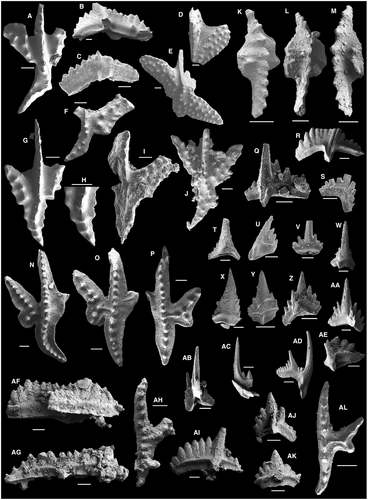
LSID
urn:lsid:zoobank.org:act:EA513603-04CD-42B5-A44C-5E888F181D3F
Derivation of name
From Yanbian County, where the holotype was collected.
Holotype
Specimen NIGP 172471 from the Llandovery Xiabaizitian Formation of the Baizitian Section, Yanbian County, Sichuan Province, south-western China (Fig. 9AA)
Type locality
Middle Xiabaizitian Formation, Yanbian, south-western China.
Other material
21 platform specimens.
Diagnosis
Platform elements are scaphate with a narrow platform at the middle part of the unit. Nodes or ridges are morphologically variable.
Description
Platform element is scaphate. In oral view, the unit is long and narrow and does not develop processes. In general, the maximum length/width ratio of the unit is c. 1:3. The platform is mainly concentrated at the middle part of the unit and is relatively shorter. From the middle to the distal part of the unit, the platform becomes narrow and disappears. The inner platform and the outer platform are similar in size. The oral surface of the platform is ornamented with ridges or nodes. Small nodes are mainly located on the platform and near the platform margin. Sometimes the ridges on the platform are perpendicular to the free blade and parallel to each other. The free blade is long and distally decreases in height. In lateral view, denticles are triangular. The basal cavity is expanded.
Remarks
All platform elements develop narrow platforms. These elements are somewhat similar to those of A. aulacis illustrated by Wang & Aldridge (1996, pl. 4, fig. 10). According to the description by Wang & Aldridge (112), however, the platform element of A. aulacis has secondary processes, which are unobservable in our specimens. The platform element differs from specimens of A. tuberculatus in lacking nodose ridges on the platform, and the narrow outline in oral view. Platform specimens of Apsidognathus are morphologically variable (Wang & Aldridge 112). However, the ratio of the anterior–posterior length to the lateral extension can readily differentiate this species from other Apsidognathus species. The carina of the platform element and the ornamented platform are characteristic of Apsidognathus species and differ from ozarkodiniform elements (e.g. Pb elements of Aulacognathus and P1 elements of Ozarkodina).
It is difficult to assign other elements to the apparatus, given that specimens of other species of Apsidognathus occur in the samples.
Stratigraphic range
Telychian. Lower Pterospathodus amorphognathoides amorphognathoides Superzone in the Baizitian section.
Genus AULACOGNATHUS Mostler, 80
Type species
Aulacognathus kuehni Mostler, 80.
Remarks
Dzik (34) suggested that Aulacognathus has a similar apparatus structure to that of Astropentagnathus Mostler, 80.
Only Pa and Pb elements have been recovered from the Baizitian section. The elements assigned to the M and S position of the Aulacognathus apparatus are difficult to differentiate from those in the Ozarkodina or Oulodus apparatuses. The stelliscaphate Pa element in Aulacognathus species shows a high morphological variability (e.g. Aulacognathus bullatus (Nicoll & Rexroad) and Aulacognathus borenorensis Bischoff).
Aulacognathus bullatus (Nicoll & Rexroad, 82)Figure 10A, B
-
- 0107
-
- Spathognathodus sp. ex. aff. Spathognathodus celloni Walliser, p. 74, figs 17, 18.
-
- 82
-
- Neospathognathodus bullatus Nicoll & Rexroad, p. 44, pl. 1, figs 5–7.
-
- 1
-
- Neospathognathodus bullatus Nicoll & Rexroad; Aldridge, p. 126, pl. 3, fig. 15.
-
- 53
-
- Aulacognathus bullatus (Nicoll & Rexroad); Klapper & Murphy, p. 26, pl. 2, figs 15–20.
-
- 2
-
- Aulacognathus bullatus (Nicoll & Rexroad); Aldridge, pl. 1, figs 1, 6, 7.
-
- ? 126
-
- Aulacognathus bullatus (Nicoll & Rexroad); Zhou & Zhai, p. 269, pl. 65, fig. 8.
-
- 29
-
- Aulacognathus bashanensis Ding & Li, p. 15, pl. 1, figs 16–17.
-
- 83
-
- Aulacognathus bullatus bullatus (Nicoll & Rexroad); Over & Chatterton, pl. 3, figs 1, 2, 6.
-
- 49
-
- Aulacognathus bullatus (Nicoll & Rexroad); Yu in Jin et al., pl. 3, figs 1, 3; pl. 5, figs 2, 5.
-
- 6
-
- Aulacognathus bullatus (Nicoll & Rexroad); Armstrong, p. 62–64, pl. 6, figs 1, 2, 4–7.
-
- 112
-
- Aulacognathus bullatus (Nicoll & Rexroad); Wang & Aldridge, p. 110, 112, pl. 27, figs 13–16.
Material
3 elements.
Remarks
This species has been reported from Llandovery strata worldwide and is considered as the earliest species of the Aulacognathus lineage (Over & Chatterton 83). The Pa elements are morphologically variable. Armstrong (6) recognized a Pa element with a long carina and limited basal platform. Both inner and outer lateral processes are relatively broad, bearing nodes or ridges, extending anteriorly in oral view. The Pa specimen from the Baizitian section is characterized by two broad lateral processes, ornamented by several relatively low nodes and weakly developed ridges. It resembles the specimens illustrated by Klapper & Murphy (53, pl. 2, figs 16, 17) and Armstrong (6, pl. 6, fig. 1) in the posterior process and the shape of the lateral processes, but has lower nodes. The specimen from the Canadian Cordillera of McCracken (74, pl. 3, fig. 2) is very similar to the present specimen. The posterior process of our specimen shows a bending in oral view. The distal part of the posterior process extends to the inner side. The central part of the posterior process is slightly arched outwards.
The Pa element of A. bullatus shares morphological features with several other Aulacognathus species erected by Bischoff (11) from New South Wales, such as A. bifurcatus Bischoff and A. angulatus Bischoff. The Pa element of Aulacognathus bullatus is characterized by a smooth posterior process, while A. bifurcatus has a bifurcate posterior process in the Pa element. A. angulatus differs from A. bullatus by a narrow platform of the Pa element. The transverse ridges on the inner lobe characterize the Pa element of Aulacognathus liscombensis in Bischoff (11). In light of the common morphological variability in Aulacognathus, particularly regarding specimens of A. bullatus reported previously, Aulacognathus liscombensis may represent a possible junior synonym of Aulacognathus bullatus.
Stratigraphic range
This species is known only from the lower Telychian Stage.
Aulacognathus chapini (Savage, 94)Figure 10C–E
-
- 94
-
- Neospathognathodus chapini Savage, p. 717, fig. 8A–F.
-
- 83
-
- Aulacognathus chapini (Savage); Over & Chatterton, p. 21, pl. 3, figs 13, 14, 21.
-
- non 74
-
- Aulacognathus chapini (Savage); McCracken, p. 108, pl. 3, fig. 3.
-
- ? 74
-
- Aulacognathus sp. aff. A. latus (Nicoll & Rexroad); McCracken, p. 108, pl. 3, fig. 4.
-
- 61
-
- Aulacognathus cf. chapini (Savage); Loydell et al., fig. 14k.
-
- 125
-
- Aulacognathus chapini (Savage); Zhang et al., figs 10.23–10.24.
Material
3 elements.
Description
Stelliscaphate Pa element, with broken anterior process and inner anterolateral processes, and with outer anterolateral and posterior processes preserved. On oral view, the angle between the inner and outer lateral processes is c. 90°, and the angle between the anterior and posterior processes is c. 120°. Many small discrete denticles are developed on the outer lateral process and posterior process. The posterior process is long and broad, bearing unclear rows of nodes. The posterior process bifurcates at one-third of its length, with the outer part bearing a few nodes. The main blade bends outward, close to the bifurcated part. The outer lateral process is broad and bears discrete denticles. The outer lateral process and posterior process are roughly parallel to each other.
Remarks
This species is characterized by the Pa element having a broad platform, which branches into broad inner and outer anterior lateral processes (Savage 94). As suggested by Over & Chatterton (83), two types of Pa element can be differentiated according to the oral ornamentation on the lateral processes. The specimens figured by Loydell et al. (61 fig. 14k) and Zhang et al. (125 fig. 10.23) have relative narrow posterior processes and regular denticulation on lateral processes. The morphology of the broken Pa specimens at hand is similar to the material illustrated by Savage (94) and Over & Chatterton (83). The bifurcated posterior process of one specimen, however, is distinctly different from any material previously reported and probably representing an intraspecies variation.
Stratigraphic range
The species is documented from the upper Telychian stage (Savage 94; Molloy & Simpson 79)
Aulacognathus sp. AFigure 10G, H
Material
One P1 element.
Remarks
The angle between the outer lateral process and the posterior process of the Pa element is similar to that of A. borenorensis. The inner lateral process is parallel to the distal posterior process, resembling the specimens illustrated by Bischoff (11). The morphology of the Aulacognathus Pa elements is variable within species, especially within A. borenorensis (Bischoff 11). However, the specimen in our collection differs from the typical specimens of A. borenorensis in lacking nodose ridges on the ornamentation of the oral surface.
The posterior process is relatively long and bent inwardly at one-quarter from the posterior end, which is different from A. borenorensis. The tendency to develop a branched posterior process is also different from A. borenorensis.
Stratigraphic range
Upper Telychian. The Kockelella ranuliformis Zone in the Baizitian section.
Genus PTEROSPATHODUS Walliser, 0107
Type species
Pterospathodus amorphognathoides Walliser, 0107.
Pterospathodus amorphognathoides amorphognathoides Walliser, 0107Figure 10N–AE
-
- 0107
-
- Pterospathodus amorphognathoides Walliser, p. 67, pl. 15, figs 11–15.
-
- 65
-
- Pterospathodus amorphognathoides amorphognathoides Walliser; Männik, p. 1021–1035, pl. 4, figs 1–20, 22–27, pl. 5; Text–figs 11–15.
-
- 51
-
- Pterospathodus amorphognathoides Walliser; Jin et al., pl. 1, fig. 5.
-
- 51
-
- Ozarkodina gaertneri Walliser; Jin et al., pl.1, fig. 20.
-
- 30
-
- Pterospathodus amorphognathoides Walliser; Dong & Wang, p.154, pl. 8, fig. 15, ?fig. 18; pl. 9, figs 1, 3–5, 7, 9, 11, 14.
-
- 2007
-
- Pterospathodus amorphognathoides amorphognathoides Walliser; Zhang & Barnes, p. 509, figs 10.30–10.35.
Material
70 Pa elements.
Remarks
Männik (65) identified the Pa element of Pterospathodus amorphognathoides with wide platform ledges as the subspecies P. a. amorphognathoides. A few Pa elements representing different morphotypes have been found in the Baizitian section. They are similar to those illustrated by Männik (65), but the inner lateral process is situated further from the main row. Other elements recovered agree well with those illustrated by Männik (65). This subspecies has rarely been reported from South China.
Stratigraphic range
Elements of P. a. amorphognathoides are present from the Telychian to the lowest Sheinwoodian (Jeppsson 44; Männik 65).
Pterospathodus amorphognathoides cf. lennarti Männik, 65Figure 10AL
-
- cf. 65
-
- Pterospathodus amorphognathoides lennarti Männik, p. 1019, pl. 3, figs 21–46; text–fig. 9.
Material
One Pa element.
Description
Pa element is pastiniscaphate, and the middle part of its main denticle row is straight. The anterior process is incurved; the posterior process is slightly curved. A bifurcate inner lateral process is developed; the anterior secondary process bears three to four denticles, and the posterior secondary process bears one small denticle. The first denticle on the inner lateral process is distant from the main row of denticles. A high ridge connects the inner lateral process and the main blade.
Remarks
The Pa element of this species is similar to that of P. a. lennarti. However, it can be distinguished from P. a. lennarti by its relatively wide platform ledges.
Stratigraphic range
This taxon is present in the lower Pterospathodus amorphognathoides amorphognathoides Superzone in the Baizitian section.
Pterospathodus procerus (Walliser, 0107)Figure 11P–AI
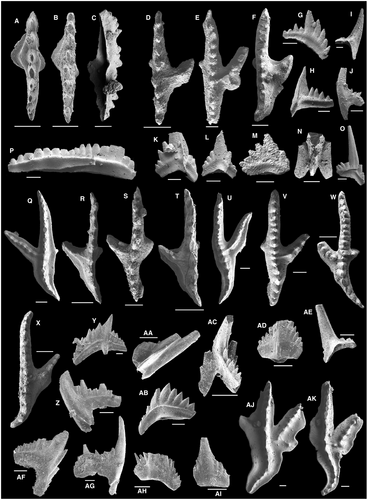
-
- 0107
-
- Spathognathodus pennatus procerus Walliser, p. 80, pl. 15, figs 2–8.
-
- 122
-
- Pterospathodus pennatus procerus (Walliser); Yu, pl. 1, figs 1, 2.
-
- 11
-
- Pterospathodus procerus (Walliser); Bischoff, p. 204, pl. 29, figs 9–10, 15–30.
-
- 74
-
- Pterospathodus procerus (Walliser); McCracken, p. 109, pl. 4, figs 12–23.
-
- 65
-
- Pterospathodus pennatus procerus (Walliser); Männik, p. 1037, pl. 6, figs 1–25, 27–35, text–fig. 16.
-
- 58
-
- Pterospathodus pennatus procerus (Walliser); Li & Qian, p. 97, pl. 1, figs 9, 10.
-
- 115
-
- Pterospathodus pennatus procerus (Walliser); Wang et al., p. 234, pl. 1, figs 4–6.
-
- 115
-
- Pterospathodus pennatus pennatus (Walliser); Wang et al., p. 234, pl. 1, figs 7, 8.
-
- 51
-
- Pterospathodus pennatus procerus (Walliser); Jin et al., pl. 1, fig. 4.
-
- 30
-
- Pterospathodus pennatus procerus (Walliser); Dong & Wang, pl. 8, figs 16, 19.
-
- 30
-
- Roundya latialata Walliser; Dong & Wang, pl. 8, fig. 18.
-
- 112
-
- Pterospathodus procerus (Walliser); Wang & Aldridge, p. 62, 64, pl. 15, figs 1–3.
-
- 119
-
- Pterospathodus pennatus procerus (Walliser); Wang et al., fig. 4V–W.
Material
429 Pa elements.
Remarks
The apparatus of P. procerus has been documented by Männik (65). It includes Pa, Pb1, Pb2, Pc, M1, M2, Sa, Sb1, Sb2, Sc1, Sc2, Sc3, carnuliform morphs a and b, and carniciform elements. The present material confirms the apparatus reconstruction of P. procerus by Männik (65).
Bischoff (11) proposed the subspecies P. pennatus procerus introduced by Walliser (0107) as being at the species level and for the first time describes it as the distinct species P. procerus by comparing ‘M’ and ‘S’ elements of his P. pennatus with P. procerus. The M elements of P. procerus recognized by Bischoff (11) are equivalent to the S element recognized by Männik (65). Dumoulin et al. (32) and Wang & Aldridge (112) also recorded this species as P. procerus.
Männik (65) proposed an evolutionary lineage for P. pennatus: P. p. pennatus – P. p. procerus. However, this lineage has not been recognized in our collections or in other material (e.g. Wang & Aldridge 112; Zhang et al. 125). Within P. procerus, two morphotypes of the Pa element without an outer pennate lateral process can be distinguished on the basis of our collections from the Baizitian section. The earlier morph is characterized by its narrow blade; the younger morph has distinct platform ledges; the transitional morph bears wider platform ledges either on the anterior process or the posterior process.
Stratigraphic range
The species is documented from the middle Telychian to the lower Sheinwoodian (Zhang et al. 125; this study).
Pterospathodus rhodesi (Savage, 94)Figure 11AJ–AK
-
- 99
-
- Pterospathodus n. sp. A Stouge & Stouge, p. 109, pl. 1, figs 1–6.
-
- 94
-
- Pterospathodus amorphognathoides rhodesi Savage, p. 714, fig. 3A–T.
-
- 122
-
- Xianzadontus dewukaxianensis Yu, p. 25, pl. 1, fig. 14.
-
- 122
-
- Ozarkodina gaertneri Walliser; Yu, p. 25, pl. 1, fig. 8.
-
- 11
-
- Pterospathodus latus Bischoff, p. 197, pl. 30, figs 15–18, 31; pl. 31, figs 1–14.
-
- ? 11
-
- Pterospathodus procerus (Walliser); Bischoff, p. 204, pl. 30, figs 3–11.
-
- 83
-
- Pterospathodus pennatus rhodesi (Savage); Over & Chatterton, p. 21, pl. 4, figs 5, 6.
-
- 68
-
- Pterospathodus rhodesi (Savage); Männik & Aldridge, text–fig. 4A–B.
-
- 6
-
- Pterospathodus amorphognathoides Walliser; Armstrong, p. 115, pl. 19, figs 1–5.
-
- ? 0104
-
- Pterospathodus pennatus pennatus (Walliser); Vorozhbitov, pl. 2, figs 8, 9.
-
- 0104
-
- Pterospathodus praeamorphognathoides Vorozhbitov, pp. 91, 93, pl. 6, figs 13–16.
-
- 89
-
- Pterospathodus rhodesi (Savage); Rickards et al., fig. 2b.
Material
22 Pa elements.
Remarks
Remarkably wide platform ledges characterize the Pa element of P. rhodesi, as in the specimens illustrated by Savage (94). The Pa and Pb elements from the Baizitian section are morphologically variable and similar to those illustrated by Savage (94) and Bischoff (11).
As noted by Männik (65), all elements of P. rhodesi can be distinguished from P. a. amorphognathoides by their extremely wide platform ledges when both species co-occur. Also, the Pa elements of P. rhodesi have an irregular outline of the basal platform that is different to those of P. a. amorphognathoides.
Note that P. rhodesi is documented here for the first time from South China.
Stratigraphic range
The species is known from the middle to the upper Telychian.
Pterospathodus sp. AFigure 12A–G
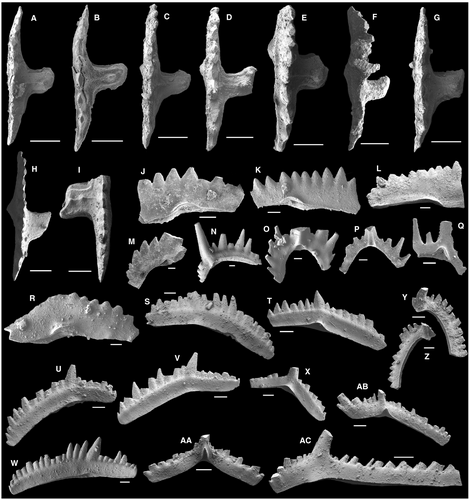
Material
57 Pa elements.
Description
Pa element is pastiniscaphate. The main blade bears c. 10–13 denticles. The anterior and posterior processes are slightly curved. The outer lateral lobe may be present. The inner lateral process is lobe-like and bears one small denticle. The denticle on the inner lateral process is located at some distance to the main blade. A ridge connects the denticle on the inner lateral process with the main blade.
Remarks
The Pa element of this species is similar to that of P. a. lennarti regarding the connecting ridge. However, it differs from P. a. lennarti by having a lobe-like inner process rather than a bifurcate or pennate lateral process.
The origin of this species is unknown. The lobe-like process is morphologically similar to the characters of P. amorphognathoides. However, the Pa elements of this species are small and possibly represent juvenile specimens.
Stratigraphic range
Specimens of this taxon are present in the lower Pterospathodus amorphognathoides amorphognathoides Superzone in the Baizitian section.
Order PROTOPANDERODONTIDA Sweet, 0101Family DREPANOISTODONTIDAE Fåhræus & Nowlan, 35Genus DECORICONUS Cooper, 20
Type species
Paltodus costulatus Rexroad, 88.
Remarks
Cooper (20, 21) assigned the Silurian species Acodontiodus mibutus Serpagli, Drepanodus aduncus Nicoll & Rexroad, and Paltodus fragilis Branson & Mehl to Decoriconus. The apparatus of D. fragilis reconstructed by Cooper (21) is trimembrate, including acontiodontiform, paltodontiform and drepanodontiform elements. The Ordovician Decoriconus apparatus reconstructed by Löfgren (60) comprises Pa, Pb, Sa, Sb, Sc, and Sd elements in PMS notation (Sweet & Schönlaub 0102). The actual position of elements in the Decoriconus apparatus is unclear so far. We followed the terminology of Cooper (21) to describe the Decoriconus apparatus. The terminologies of Barrick (7) and Armstrong (6) are not applied in this study.
Decoriconus fragilis (Branson & Mehl, 13)Figure 13L–R
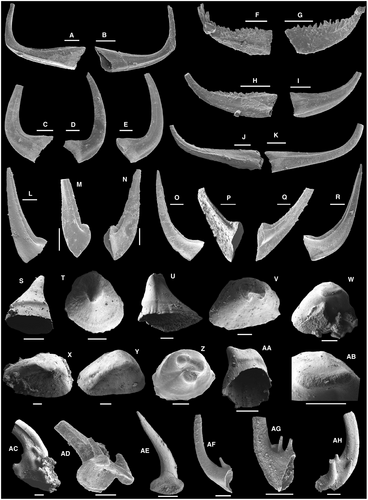
-
- 13
-
- Paltodus fragilis Branson & Mehl, p. 43, pl. 3, fig. 6.
-
- 21
-
- Decoriconus fragilis (Branson & Mehl); Cooper, pp. 212–213, pl. 2, figs 5, 8, 14–17 (cum synonymy).
-
- 7
-
- Decoriconus fragilis (Branson & Mehl); Barrick, pp. 53–54, pl. 2, figs 15, 21–23.
-
- 75
-
- Decoriconus costulatus (Rexroad); McCracken & Barnes, pp. 75–76, pl. 2, figs 24–27.
-
- 73
-
- Decoriconus fragilis (Branson & Mehl); McCracken, pp. 79–80, pl. 4, figs 33, 39.
-
- 124
-
- Decoriconus fragilis (Branson & Mehl); Zhang & Barnes, pp. 11, 13, figs 15.25–15.31.
-
- 36
-
- Decoriconus fragilis (Branson & Mehl); Farrell, pp. 958, pl. 12, figs 11, 12, 14, 17.
-
- 100
-
- Decoriconus fragilis (Branson & Mehl); Suttner, pp. 19–20, pl. 7, figs 12–21.
-
- 2007
-
- Decoriconus fragilis (Branson & Mehl); Zhang & Barnes, p. 505, figs 9.10–9.15.
Material
2569 elements.
Remarks
This species was erected by Cooper (21). Most of the specimens in our collections coincide with the diagnosis emended by Barrick (7) and Armstrong (6). However, there is considerable variability in the elements than described by Cooper (21), Barrick (7), Armstrong (6), McCracken (73) and Zhang & Barnes (124). Based on the St Clair Formation, Illinois, USA, Cooper (21) noted that the species includes four conical elements. The occasional drepanodontiform elements, interpreted as a transitional element from acontiodontiform to drepanodontiform, was excluded from the D. fragilis apparatus (Cooper 21). Barrick (7) illustrated an Sa–Sb element, equivalent to the paltodontiform–acontiodontiform element, as having a straight cusp and a slightly flared basal cavity. However, the paltodontiform element illustrated by Barrick (7) is different to that illustrated by Cooper (21) in the upper margin of the base. Suttner (100) described four elements of D. fragilis from the upper Silurian, that is, the Sa, Sb, Sb? and Sa–Sb elements. As mentioned above, it is apparent that no fewer than four forms of element can be assigned to this species. The Baizitian collections show that the D. fragilis apparatus might contain four elements: straight acotiodontiform, twisted acotiodontiform, drepanodontiform and paltodontiform elements.
All elements in the D. fragilis apparatus are commonly variable. Zhang & Barnes (124) observed that the anticusp-like lower anterior margin of the drepanodontiform element is a variable character, which can be confirmed in this study.
Stratigraphic range
From Upper Ordovician to Lower Devonian (Suttner 100; Zhang et al. 125).
Family PSEUDOONEOTODIDAE Wang & Aldridge, 112Genus PSEUDOONEOTODUS Drygant, 31
Type species
Oneotodus? beckmanni Bischoff & Sannemann, 12.
Pseudooneotodus linguicornis Jeppsson in Calner & Jeppsson, 15Figure 13X, Y
Material
2 elements.
Remarks
Männik & Małkowski (69) first reported this species based on the material from Poland. Jeppsson (in Calner & Jeppsson 15) suggested that the slightly recurved tip can serve as a character to separate Pseudooneotodus linguicornis from P. bicornis in Sweden. The outline of the basal cavity is subtriangular or elliptical. Our specimens from Baizitian are distinctly concave near their posterior end, thus, they differ slightly from the Swedish material, but are considered herein to represent an intraspecies variation.
Stratigraphic range
The species is documented from the Ozarkodina sagitta sagitta and Ozarkodina bohemica longa zones (Corradini 23; Loydell et al. 62).
Division PRIONIODONTIDA Dzik, 33Family DISTOMODONTIDAE Klapper, 52Genus JOHNOGNATHUS Mashkova, 71
Type species
Johnognathus huddlei Mashkova, 71.
Remarks
Mashkova (71) was the first to describe the genus Johnognathus, which has been documented by many authors (Aldridge & Mohamed 3; Mabillard & Aldridge 63; Savage 94; Bischoff 11; Vorozhbitov 0104). Considering that the segminiscaphate Pa element is similar to the broken process of the Pa element of Distomodus staurognathoides, all Johnognathus form elements were assigned to Distomodus based on the material from the Mackenzie Mountains, Canada (Over & Chatterton 83, b). According to Bischoff (11), however, the Pa element of Johnognathus has an almost complete platform and a fan-like anterior platform. In addition, the denticles on the platform have different shapes of processes from that of Distomodus (Bischoff 11). Therefore, Johnognathus form elements might represent an apparatus.
Johnognathus sp. AFigure 14L, M
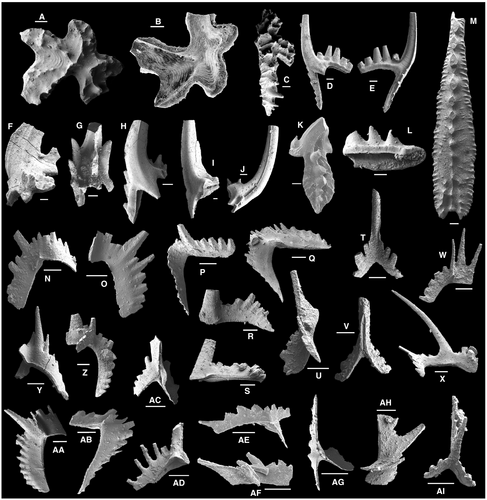
Material
8 elements.
Remarks
According to Bischoff (11), the Pa elements of Johnognathus are highly variable. The Pa element in our collections is characterized by a lanceolate outline and large axial denticles. The present Johnognathus sp. A differs from J. huddlei by the Pa element having successive denticles on the platform and lacking the fan-like anterior platform margin.
Stratigraphic range
From the Pterospathodus eopennatus Zone to the Pterospathodus amorphognathoides amorphognathoides Superzone.
Acknowledgements
We are grateful to Drs George D. Sevastopulo and Sally Thomas for their editorial handling of this manuscript and Drs Carlo Corradini, Ian G. Percival, and an anonymous referee for their constructive suggestions and comments. We thank Drs Renbin Zhan, Yi Wang, Peng Tang, and Guangxu Wang for their assistance in the field, and Mr Hongyong Zhang for assistance in the laboratory. We are indebted to Dr Lehnert Oliver for reading the manuscript and polishing the language. This study is funded by the National Natural Science Foundation of China (grant no. 41672008) and the Strategic Priority Research Program of the Chinese Academy of Sciences (grant no. XDB26000000). This paper is a contribution to IGCP project 653: The onset of the Great Ordovician Biodiversification Event.
Data archiving statement
Data for this study are available in the Dryad Digital Repository: https://doi.org/10.5061/dryad.zpc866t7b.
This published work and nomenclatural act it contains, have been registered in ZooBank: http://zoobank.org/References/655F5D35-2C22-4A5F-BBE5-00E7DAED1E2C.



